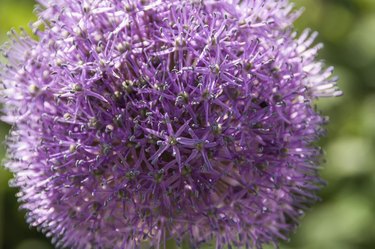
Alliums (Allium spp.) span a broad range of garden favorites from ornamental bulbs to kitchen-garden essentials most cooks can't be without. Depending on species and variety, they may grow in U.S. Department of Agriculture plant hardiness zones 3 through 10. True bulbs with differing life cycles, alliums have different planting times.
Ornamental Alliums
Video of the Day
Sometimes called flowering onions, ornamental alliums (Allium spp.) provide color from early spring well into summer. With varieties hardy from USDA zones 3 through 10, ornamental allium bulbs should be planted in fall. Plant the bulbs in full sun in soil with excellent drainage after ground temperatures drop below 60 degrees Fahrenheit. This is roughly six weeks before your garden typically freezes, if it does. Fall planting means the plants can establish their roots before winter and prepares the bulbs for early spring growth. Warm-climate alliums may be planted up until the end of December, but earlier is better.
Video of the Day
Culinary Onions
Usually grown as annuals, garden onions (Allium cepa) are biennial bulbs. Growing in USDA zones 5 through 10, they naturally live two years. The first year the bulb grows -- and is harvested in most gardens. Left alone, the onion plants set seed and die the second year. When growing onions from immature bulbs, called sets, planting time depends on where you live and the type of onion you grow. Onion sets grow best in cool weather, followed by warmth. For most areas, sets fare best with late-winter or early-spring plantings. Day length also enters in with planting time. Short-day onions produce bulbs during short spring days. If your climate and latitude allow, plant short-day onions in fall.
Inspirational Garlic
Allium is the Latin word for garlic (Allium sativum). Growing in USDA zones 4 through 9, these biennials are grown from immature bulbs called cloves. Individually wrapped, cloves make up the segments of the mature garlic bulb, known as a head. In mild climates, garlic cloves can be planted in midwinter, but fall-planted garlic consistently produces larger, better quality crops. Plant garlic cloves about one month before your ground normally freezes. Temperatures should be low enough that roots grow, but tops don't. The roots continue to grow as long as temperatures remain above 40 degrees Fahrenheit.
Why Timing Matters
Alliums react to seasons differently. Many ornamental alliums need winter chill to produce their blooms. Low temperatures trigger the reaction that brings on flowers. Warm-climate alliums don't require chill, but they need fall planting for root development. Immature onions sets were interrupted in their bulb life cycle. They react to spring planting and cool weather as though they're still in year one. Fall planting in warm climates causes sets to flower, or bolt, instead of maturing. Garlic requires 40 days of temperatures below 40 degrees Fahrenheit, which fall planting naturally provides. Without it, the heads won't divide and you're left with onionlike bulbs instead of cloves.
- Fine Gardening: Alliums All Season Long
- The San Diego Union Tribune: Alluring Alliums
- University of California Sonoma County Master Gardeners: Bulbing Onions
- The National Gardening Association: Planting Onions
- Growing for Market: How and When to Plant Garlic
- Missouri Botanical Garden: Allium
- University of Illinois Extension: Bulb Basics
- Fine Gardening: How to Plant Alliums
- Canadian Gardening: Attention-Grabbing Alliums